"A broom for sweeping trenches"
The term "broom for sweeping trenches" was born in 1918 with the appearance of one of the most famous and successful submachine guns in stories, created by American engineer General John Talaferro Thompson. With the help of this deadly "machine", which had a high rate of fire (higher than that of most of the then machine guns) and fantastic for weapons under the pistol cartridge firing range - up to 450 m! - Allies supposed to crack the German defense on the Western Front. The end of the war prevented the execution of this plan. But the Thompson submachine gun - the first successful weapon in its class - lived a long life and its technical characteristics remained an unattainable ideal for most small arms designers. The demands of the new world war forced the generals and soldiers of the Allied armies to put up with the shortcomings of a submachine gun, for they turned out to be insignificant compared to its merits.
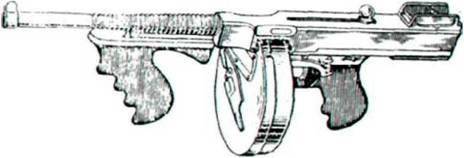

When designing his weapon, J. T. Thompson decided to achieve high performance through the use of a powerful Colt .45 ACP pistol cartridge (11,43x22 mm) and the optimization of internal ballistic PP with a bolt locking the barrel when fired. Thus, PP Thompson refers to a type of semi-free-bolt weapon - there was a bronze crawler in the slide frame, sliding along inclined grooves. At the time of the shot between the slider and the groove wall, there was a tremendous friction force that kept the bolt in the locked position until the pressure in the barrel dropped. Further, the friction weakened, the shutter was unlocked and went back. By applying this design, Thompson also achieved a reduction in the rate of fire to an acceptable level in 550 rds / min, and also reduced the length of the bolt box - the semi-free gate did not need a large “shooter”. From the outset, the Thompson PP was thought out to the smallest detail. For convenience, the gun had two pistol handles — front and rear — which ensured a comfortable grip of the weapon and the possibility of faster transfer of fire from target to target — yet the vertical position of the palms for the person is most convenient. Both handles were made with the claim to the anatomicality - they had recesses for fingers. In addition, in the presence of the front handle, the shooter almost went to no risk of catching on the hot barrel of the weapon when firing offhand.
The first, experimental model of the American PP appeared in 1918, shortly before the end of hostilities. For reasons of adaptability, PP was simplified - there was no fire selector, shoulder rest, flame arrester. Sighting device was the most primitive. The barrel was protected by a casing from a water pipe. By the way, the use of water pipes in the construction of PP in the future is widely practiced - it was the most easily accessible and cheap tubular semi-finished products.
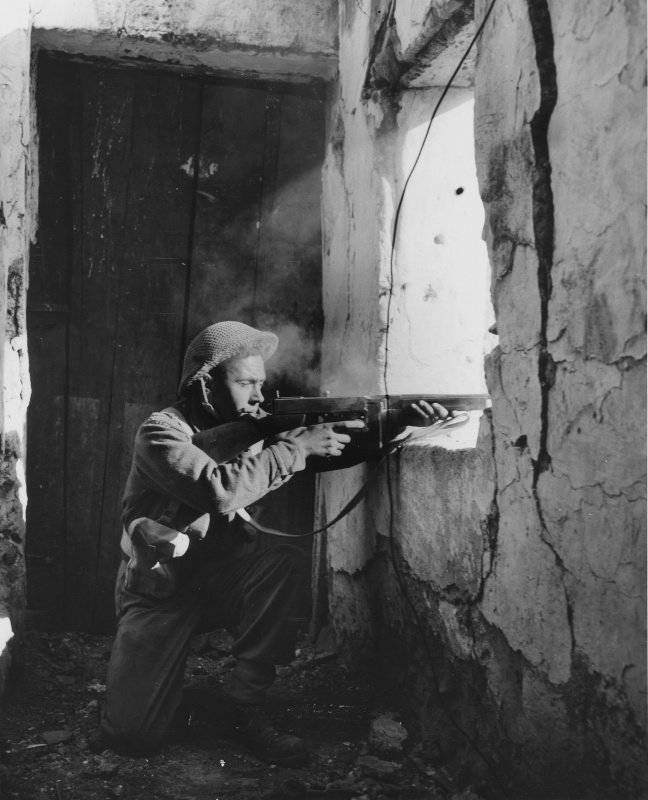
The end of the war put an end to most American military programs, including the Thompson PP program. But, being a good merchant, General Thompson began to modernize his product for commercial use. Appeared advertising name PP - "Annihilator." The weapon received a longer barrel without a casing, but then with ribbing, which improved its cooling. A detachable wooden butt was docked to the back of the sturdy, solid-milled boltbox. The fire selector allowed both single and automatic fire. The aiming device of the frame type was designed for firing at two distances - 250 and 500. To increase the accuracy of the battle, a muzzle compensator was screwed onto the barrel with four kerfs oriented upwards. The cocking handle was conveniently located on top of the bolt box, which made it possible to put the weapon on a combat platoon with both the right and left hand. PP could be used with three types of magazines: a compact horn for 20 cartridges and discs for 50 and 100 cartridges! The cartridges used two types of bullets - HP with a steel core and E - soft lead. The latter had an exceptionally high stopping power, even at maximum range.
PP Thompson sample 1921 g. Had only two serious flaws. Firstly, it was heavy - 4,9 kg without a store. And secondly, almost all the details of the weapons were carried out on metal-cutting machines with minimal tolerances, which was extremely non-technological. The cost of the software took off literally up to heaven - in the full configuration, the “Annihilator” cost 98 dollars at the rate of 1922 g. For comparison, the Koltovsky gun M1911А1 in gun stores was worth only 2-2,5 dollar! This explains the fact that the American soldiers did not receive the Thompson product until the beginning of a new world war. But Thompson did not experience a shortage of orders - on the contrary, sometimes there were too many for a relatively small arms factory. It makes no sense to say who was the customer of the "Annihilators" - everyone knows this weapon very well from films like "Only Girls In Jazz". The American gangsters successfully licked each other with lead from these “machines” for a good three and a half decades, until a small X-machine, the 45 caliber of the Ingram system, was born.
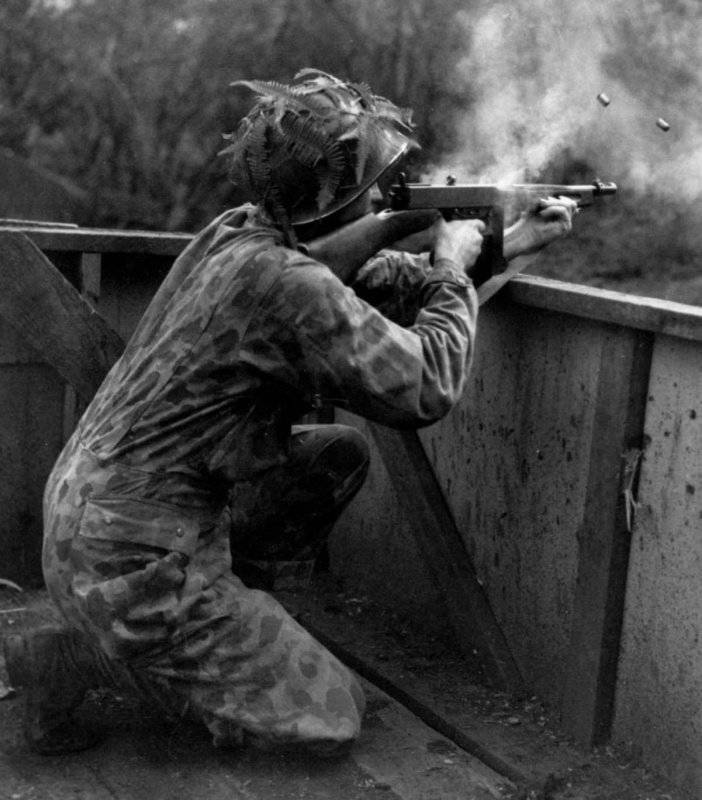
Thompson repeatedly appealed to the Ministry of Defense with proposals to sell a batch of machine guns. The army presented an ultimatum: there will be no orders until the purchase price of the weapon is halved! The easiest way to do this was to simplify the technology. As a result, a modification of 1923 appeared - the famous "Tommy Gun": it was decided to abandon the bronze liner - the shutter of the new modification became free. The bolt box was stamped from steel sheet. The trunk became longer and lost the fins, instead of the front handle under it began to install the pad - the forearm. Muzzle compensator was abolished, but at the end of the barrel appeared a device for attaching the bayonet. Were released models for pistol cartridges of calibers .351 and .38 (9x18 mm), as well as for an extended cartridge .45 "Thompson" (11,43x25 mm). In this form, the cost of PP fell to 46 dollars, which still did not suit the army. General Thompson’s weapons were only interested in the FBI. For detectives, models with a simplified sight, a conical heavy barrel, an elongated forearm and a muzzle compensator (model 1927 / 28) were produced, and, in general, they were unable to conduct automatic fire. This model received the name "Anti-Bandit Gan" - anti-gang weapon. Interestingly, Antibendit was produced with both a free and a semi-free shutter.
The Second World War forced the US Department of Defense to stop reckoning with costs - the army needed automatic individual weapons. The undeservedly forgotten Tommy Gun was returned to production. In parallel in 1942, the production of the PP model of 1928 was established, but even more simplified, "adapted" for mass production. The main external difference of the army "Thompson", which received the M1A1 index, was a free bolt and a cocking handle on the right side of the bolt box. M1A1 was produced at Auto Ordnance plants. In addition, early, most advanced Thompson PP models began to be produced in limited quantities again. They were adopted by the Marines, tank crews, pilots. Under Lend-Lease, Thompson's PPs (mainly of early modifications) were delivered to the UK, where they earned love and respect from tank crews, bombers, as well as from paratroopers and soldiers who fought in Africa against Rommel. A certain number of Thompson M1A1s entered the USSR, however, our soldiers liked the lighter, longer-range and less awkward PPSh. In addition, the Red Army has always felt a shortage of cartridges of the 45th caliber.
Section of a submachine gun arr. 1921 g. With a short barrel
There was a shot, the bolt is on combat platoon and guard, the translator is on a single fire, the circuit breaker has come out of the trigger box, the drummer is in the rear position, as the trigger lever does not push it.
Section of a submachine gun arr. 1923
The magazine is inserted, the bolt is in the forward position, the lock insert (11) locks the bolt in the lower position, the trigger lever (10) pressed the drummer who smashed the cap.
1 — barrel; 2 - gate box; 3 — bottom of the box; 4 - butt; 5 - shutter; 6 - return spring; 7 - guide rod; 8 - drummer with a spring; 9 - uncoupler; 10 - trigger lever; 11 - lock insert; 12 - shutter handle; 13 - trigger; 14 - the trigger lever with a spring; 15 - trigger thrust with spring; 16 - trigger pad with a sear and spring; 17 - switch.
In the UK, the limited edition series was released by Empire Defense Gan - the same Thompson M1921, but chambered for Parabellum 9x18 mm with a rifle butt.
During the whole war the Thompson system was the main individual automatic weapon of the US Army. Its outstanding technical characteristics, as well as its durability and resistance to the ingress of sand, dust and water, made "Tommy Gan" indispensable in combat at medium distances, in melee, and in melee combat. Arrow-observers on the British aircraft "Fulmar", "Albacore", "Lizender", "Svordfish" and others, without relying especially on the dubious fire power of bulky and rather capricious defensive machine guns "Lewis", took with them in flight "Thompsons" and fought off of them from the Sugostan fighters, and not without success - the fact of the shooting down of Messerschmitt Bf 109E by the shooter "Lysander" from Thompson M1921 over France was documented.
After the war, "Thompsons" were officially decommissioned, but for a long time used by infantry and the FBI. Officially not in service in any country of the world, the PP of Thompson to date is a common type of weapon in various partisan movements. Suffice it to say that Che Guevara’s last weapon in Bolivia was Thompson M1928.
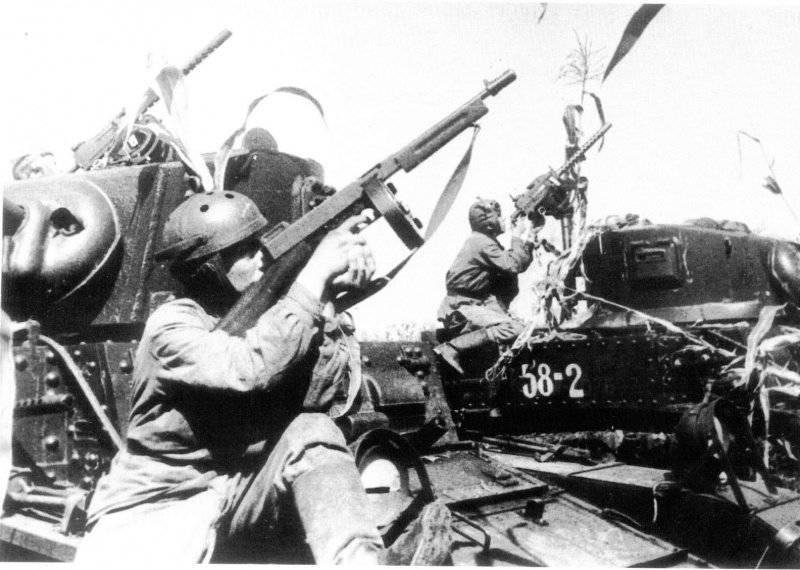
Meat mincer 45 caliber
But the special forces, first of all, the marines and airborne troops, needed another weapon - a compact PP for powerful ammunition designed for off-target fire “from the belly” with an airtight gate box, but the main thing is cheap! Such a weapon was developed in the fire order in 1942 by the artillery and technical control of the US Army. For simplicity and massiveness, as well as for the specifics of the design, the new PP with the M-3 index received the nickname “Mitmesher” from the soldiers - the meat grinder. The bolt box and other parts of the PP case were manufactured by the method of coarse stamping and joined together by welding. A breech with a barrel was screwed into the front of the hull. In the bolt box there was no slot for a cocking handle - the cocking mechanism was located under the box and was driven by a long handle that was exactly the same as the meat-twist. The ejection window of the sleeves in the stowed position was closed with a massive lid, at the same time blocking and triggering, acting as a fuse. Add to this a primitive diopter sighting device (which no one will use anyway) welded to the body tightly, a folding shoulder rest, bent out of a steel bar, a folding trigger guard for shooting in mittens and a magazine - a horn for 30 cartridges - that's what the gun is ready for -machine gun! True, he had only two advantages - low cost and compactness (relative to the "Thompson"). But the disadvantages - a whole bunch! Firstly, from M-3 it was impossible to conduct aimed shooting further than 50 meters (although the TTX indicated the value of 250 meters). Secondly, the weapon was very heavy for its small size - 4,7 kg in curb. An incomplete disassembly of the weapon was quite difficult - it was necessary to unscrew the breech with the barrel from the hull. In addition, the PP, created as a “completely sealed” weapon protected from moisture, in fact, to put it mildly, was not, And if the battles were fought near the sea, the insides of the M-3 began to corrode intensively, which led to a rapid exit of weapons out of service. The first, as a rule, "died" platoon mechanism. In 1944, a new modification of this software appeared - M-3А1, which was distinguished by the absence of the latter! The platoon was now carried out by retracting the bolt by inserting a finger into a special hole on it. The system turned out somewhat easier and much easier.
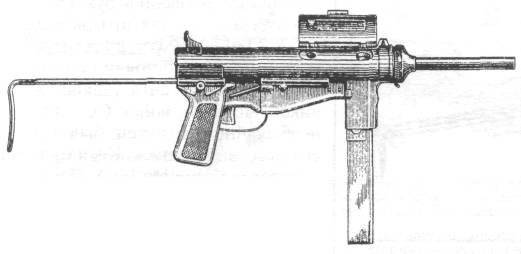
M-3 began to enter the troops operating in the Pacific Ocean, as well as in the Airborne Forces. In 1945, the Air Force and the US Navy pilots received the PP. By the way, it is with the use of M-3 in the marine aviation one curious episode is connected. A pilot from a crashed corsair in the area of Fr. Okinawa threw himself with a parachute, splashed down, safely climbed into his "air bag" and began to wait for him to be rescued. With him was the M-3 software without a horn (he drowned with the plane - keep the gun loaded!). Soon, a five-meter shark began to show unhealthy interest in a rubber boat. After a few shark snouts, the pilot realized that if he did not begin to act immediately, he would be ill. During the next shark attack, the flyer inflicted several powerful blows on the head with his M-3, holding him by the barrel. Offended by the best feelings, the shark retreated, and the pilot discovered that his gun barrel was bent!
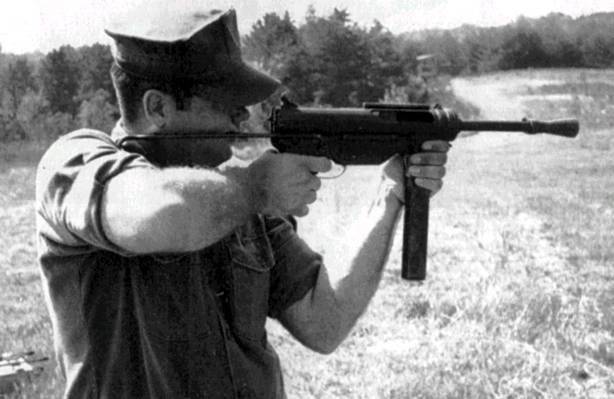
Indeed, besides purely design flaws, M-3, produced by many firms, including almost artisanal workshops, had one more - sometimes very bad steel was used to make it. However, the stock of these PPs in the American arsenals was very large, the marines armed with them participated in the Korean War, and after that the M-3 was sold all over the world - the Americans generously supplied them with friendly regimes. In Iran, M-3 was decommissioned in 1975!


Information